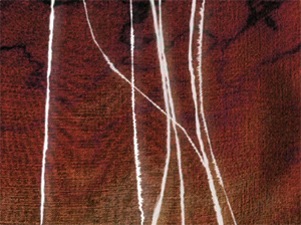When violist Rozanna Weinberger and I first began discussing a piece for viola and electronics, I started thinking about possible jumping off points. The story of Penelope, wife of Ulysses, jumped into my mind, and I thought about how her story is a kind of shadow story in relation to his. I wanted to contribute to changing this through my musical interpretation. As I mention in my program notes, Homer’s epic, the Odyssey, tells of the travails of Odysseus, who was away from home for twenty years, first at war in Troy and then, due to the sea-god Poseidon’s wrath, for ten more difficult years. It also tells of his wife, Penelope, Queen of Ithaca, waiting for him, and of the many suitors, filled with greed and arrogance, who tried to woo her so they could become king. To stave them off she devised excuses. In one, she said she would take no suitor until she finished weaving a shroud for her husband’s aged father, Laertes. But, since she unraveled at night what she wove by day, she made no progress. Instead, she actively waited for Ulysses return. This piece is a tribute to her, and sings of her own adventures.
At the time I was thinking about the piece, by chance I met a terrific local weaver, Jan Russell. She willingly allowed me to record her weaving on her beautiful wooden looms. I processed and shaped these sound sources, weaving a new sonic fabric. There is barely any sound that has not been processed – sometimes playing with rhythmic placement, sometimes using transformational filters. Laura Wilcox premiered Penelope’s Song at the Musica Viva Festival in Coimbra, Portugal in 2004, with the American premiere by Rozanna Weinberger on the annual TechnoSonics festival that same year at the University of Virginia. But I was still not satisfied with the electronics or the exact pacing of the instrumental, and continued to tinker with them for more than a year after that. There was a great deal of hands-on, ears-on work. Even when the loom sounds are recognizable, I have tweaked and rewoven the rhythms. The overall form is in three sections, with the third referring to the first, yet twisting it into shapes at times more lyrical, at times bursting out of previous confines. The middle section is dreamier, though all of the electronics come from processing of the same source soundfiles, and the viola part from stretching and twisting its own threads.
After I was finally satisfied, in 2005, a number of performers commissioned versions for their own instruments. To date, I have created versions for amplified violin, viola, cello, clarinet, flute and soprano sax. In the past, I had resisted such transformations, as I am normally fascinated by the particularity of instrumental timbre realized on a given instrument. However, during the course of these transformations, I realized that in some cases there was much to discover by reimagining the music with different instrumental timbres in my mind’s ear. And, there was the fun of collaborative play. I worked with my long-time collaborator F. Gerard Errante on the clarinet version, with soprano sax player Susan Fancher on the soprano sax version, ace performer Lindsey Goodman on flute and Hasse Borup on the violin version. There are now multiple recordings. Susan and Hasse have each recorded their versions on s the Innova label. Susan’s is on a disk of saxophone music, In Two Worlds, while Hasse’s is on a portrait album of my violin/piano/electronics pieces and is called Tower of the Eight Winds. Lindsey’s is on her album Reach Through the Sky, while Andrea’s is on her CD Somewhere on Ravello.
Penelope’s Song has become a favorite of both performers and audiences, presented in America and Europe by, among many others, clarinetist Marianne Glythfeldt; saxophonists Enzo Filipetti and Noah Getz; violists Karen Ritscher, Rozanna Weinberg and Laura Wilcox; and violinists Hasse Borup, Timothy Summers and Paul Arnold, the latter presented by the Network of New Music in Philadelphia.

